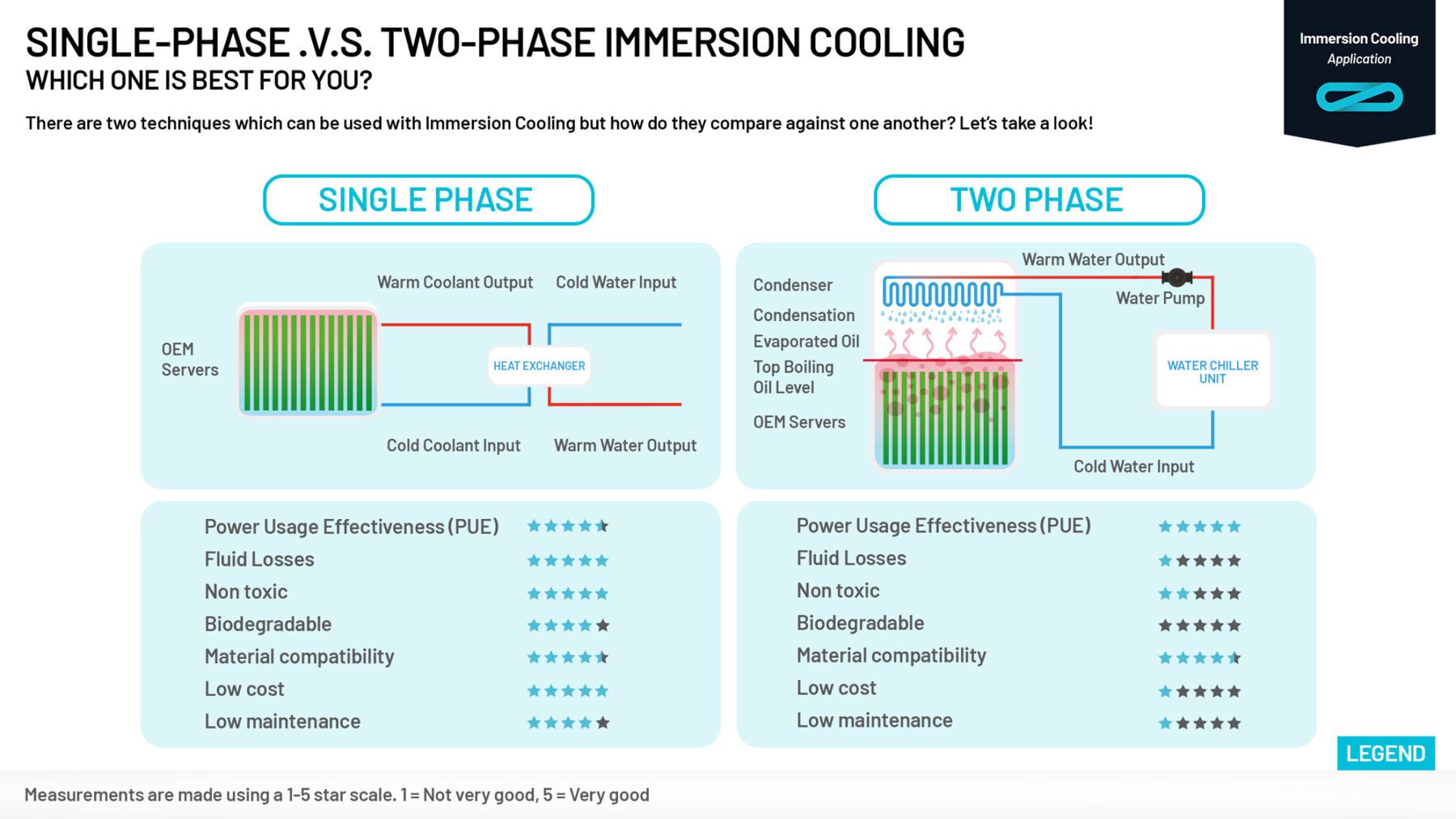If we demand power and efficiency in a datacenter, we must talk about the cooling systems that will enable a green IT infrastructure. However, immersion cooling as a method requires two different ways of cool computers and electronics. The difference starts around the dielectric liquid we decide to use in immersion. That’s why we need to talk about what is single-phase immersion cooling and also what is two-phase immersion cooling.
We need to understand the differences between each immersion cooling technique to recognize which one is better for us. This article will analyze single-phase vs. two-phase immersion cooling and help you to decide which form of Immersion cooling best meets your needs.
The Rise of Immersion Cooling: How Did We Get Here?
Power, efficiency, and sustainability are becoming increasing areas of concern for the Datacenter industry. There are a number of factors that contribute to this growth in importance, such as, 5G, AI and Machine Learning. The growing use of these kinds of technologies has led to a dramatic rise in temperatures within Datacenter infrastructure and IT equipment. Datacenters are now searching for ways to effectively cool their equipment while simultaneously reducing their effect on the environment and increasing their compute capacity.
When trying to cool Datacenters / IT equipment, there are many options available. Whether it be through air conditioning, direct-to-chip, or liquid cooling. In this post, we want to discuss what we believe is the most effective approach, liquid cooling and, more specifically, Immersion cooling.
Below we will compare single-phase and two-phase Immersion cooling, a topic which often can be confusing to both beginners and experts within the industry, to help you decide which one is right for your needs if the answer is single-phase immersion cooling or two-phase.
7 Clear Differences Between Single-Phase and Two-Phase Immersion Cooling
Let’s take a look to understand the differences between single-phase immersion cooling and two-phase immersion cooling in the infographic below.

Single-Phase Immersion Cooling
Two-Phase Immersion Cooling
Servers or other IT components are submerged in a thermally conductive dielectric liquid or coolant. The coolant never changes state, it never boils or freezes and always remains in a liquid form. The coolant gets pumped to a heat exchanger where heat is transferred to a cooler water circuit. This technique uses “open baths”, as there’s little (or no) risk of the coolant evaporating.
Servers or other IT components are submerged in a thermally conductive dielectric liquid or coolant. Heat is removed from the system by circulating the liquid into direct contact with hot components, whereby the liquid undergoes a low-temperature evaporation process to cool the hot components and transfer the heat out of the liquid. The gas is cooled again by a heat exchanging method (such as a condenser coil) to allow return flow into the larger liquid volume.
Which Technique is Right for You?
What should now be clear is, for the challenges that industry’s that use and need high-power compute, liquid cooling is a great option. The question that remains is, which form of liquid cooling is the best for you.

Both single-phase and two-phase cooling offer ease of location for datacenters thanks to their plug and play configuration and lack of dependence on traditional infrastructure. Both techniques also perform well against each other where compatibility is concerned. Users should experience almost no issues when deciding which hardware to use or retrofitting their current set-up, with many severs already compatible with Immersion.
Efficiency levels of both methods are significantly higher when comparing them to a traditional air-cooled datacenter, however current research suggests that two-phase cooling may have a slight edge over single-phase cooling, claiming a PUE of 1.02 as opposed to 1.03. The argument swings in favor single-phase cooling when levels of maintenance are taken into consideration. Typically, single-phase immersion cooling solutions require much less maintenance and are much easier to access and repair if adjustments are needed.
There are significant differences between the two immersion cooling methods when comparing the dielectric fluid. To ensure that our products meet our core values of sustainability and efficiency, we created the SmartCoolant, a non-toxic, non-flammable, biodegradable liquid that is equally non-corrosive and non-conductive.

The SmartCoolant has a lifespan of over 15 years, well above the standard lifecycle of a datacenter. Many have questioned the safety levels of fluids used in two-phase cooling for both humans and the environment. With sustainability and impact on the environment becoming an increased concern for the industry, this brings into question the longevity and application of two-phase cooling.
Conclusion: Have the Best of Both Worlds with Submer
At Submer we don’t believe in saying one technique is better than the other but what we do believe is that the combination of our expertise and years of experience puts us in a unique position to design solutions that are purpose-built to truly address the real problems that companies are facing, using forward-thinking, innovative technologies. Our solutions utilize the basic principles of single-phase Immersion cooling, elevating it to the next level by eliminating the drawbacks of two-phase Immersion cooling.
All this combined with our proprietary SmartCoolant Immersion fluid, which is sustainable, environmentally friendly and extremely cost-effective makes Submer a strong choice when deciding to dive into Immersion cooling. Don’t just take our word for it, book a call with us today and see for yourself.
Join in this video with Alexandra MacDiarmid, Daniel Pope, and Peter Cooper to understand the background of the recent announcements on fluorocarbons and PFAS and what they mean for the world of immersion.



